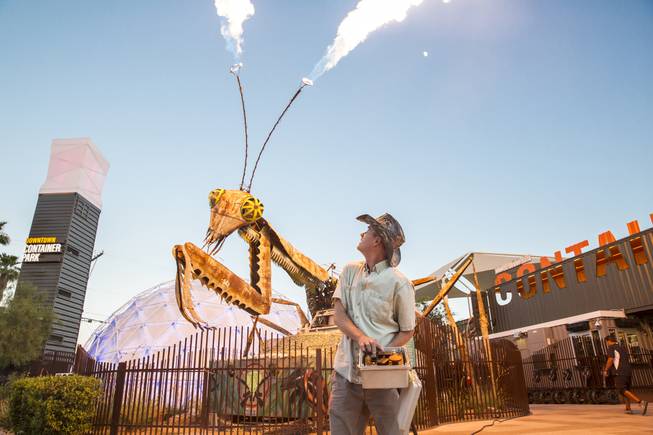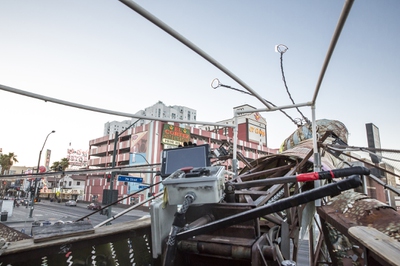Monday, July 18, 2016 | 2 a.m.
Outside the gates of Downtown Container Park, a mammoth insect with laser-beam eyes and flaming antennae greets guests, her rusted arms outstretched.
The metallic praying mantis dances and spits 30-foot balls of fire, entrancing (and hilariously terrifying) passersby. But there’s much more than meets the eye. Where do the giant flames come from? How does she speak Chinese? Why is she wearing a license plate?
Here’s a breakdown of the unofficial leading cause of spilled beverages on East Fremont Street.
Who’s behind the controls?
Inside The Mantis sits 52-year-old Merritt Pelkey, director of fire operations at Container Park. Since the bug was installed in 2013, Pelkey’s full-time job has been operating and maintaining the singular attraction. Pelkey insists that he and two other operators enjoy every second of it, even in the summer heat. “One of my favorite parts of the job is to play the music and make The Mantis dance,” said Pelkey, who updates the playlist weekly. “I play a little bit of everything, but especially songs about women because The Mantis is a woman, and she’s strong and empowering.”
Profile
• Name: The Mantis
• Description: Replica of a female praying mantis, blown up to 150 times scale
• Size: 40 feet tall and 30 feet wide when fully extended
• Weight: 22,000 pounds
• Flames: The flame-throwing antennae are fueled by two propane tanks that each hold 100 gallons.
• Sound: 4,000-watt surround stereo system and a bank of more than 200 songs
• Speech: Operators can speak through a microphone, trigger prerecorded phrases or type words for The Mantis to speak in more than 20 languages.
What’s with the fireball scares?
While Pelkey’s official stance is that it’s not his intention to scare onlookers, he does enjoy whipping off a surprise fireball on occasion. One time in particular stands out in his mind, when he jolted a couple walking down the sidewalk. “The guy hit the deck and dropped his cup,” Pelkey said, laughing. “The woman went down, off the curb, into the street, but didn’t spill a drop of her drink. Total professional. Got back up, cursed me out and then thanked me and tried to hug The Mantis through the fence.”
Mobile Mantis
The giant insect is not only mobile, she’s street legal. The Mantis is mounted on a 1983 GMC Dump Truck, complete with Nevada license plates. It’s registered, insured and ready to drive down the street with a quick adjustment of the neck and removal of the legs. “I would love to take her in a parade,” Pelkey said. “She was sort of built for that. Her legs hang just above the ground, and it’s designed so that when you drive over an uneven surface, her legs wiggle
like she’s walking.”
How did this big bug get to Vegas?
Early in her life, The Mantis served as a tour vehicle at Burning Man.
Tony Hsieh — CEO of Zappos and founder of the Downtown Project and Container Park — fell in love with the monstrosity in March 2012 at the Pastel Project, and eventually he purchased her.
The Mantis parked in her current home in front of Container Park in October 2013, just before the first Life is Beautiful festival.
20 people + 500 hours of design + 3,000 hours of labor
The Mantis was constructed in 2010 by a team led by former aerospace engineer Kirk Jellum, as a response to Jellum’s wife, Kristen Ulmer, having a 20-foot rat-shaped car built for the Burning Man art festival. Jellum created the Mantis to impress Ulmer and gave it to her on their first wedding anniversary.
Safety concerns
When the idea of a musical, metallic bug-monster blasting flames over onlookers’ heads was first pitched to the city of Las Vegas, officials were understandably skeptical.
“Right off the bat they said no,” Pelkey said. “They were like, nope, not going to happen. But we showed them other types of fire art projects and they eventually came around.”
Pelkey and others with Downtown Project worked with the city and local fire marshals for two years prior to The Mantis landing at Container Park, to build strong relationships and prove she would be safe.
Fire control
The Mantis has more safety valves on her propane tanks than the city requires, and along with a mandatory kill switch in the cockpit where Pelkey works, there is another on the exterior so security can shut the system down at any time.
Weather considerations
There is a weather station at Container Park monitoring wind, rain and approaching thunderstorms. The Mantis doesn’t operate in winds 15 mph or higher, and won’t fire up with swirling winds of 12 mph or higher. Rain can damage the machinery when firing, so that’s off limits as well. And seeing how The Mantis is basically a giant lightning rod made of steel and copper, she’s inactive when lightning is spotted within 10 miles of Las Vegas.







Join the Discussion:
Check this out for a full explanation of our conversion to the LiveFyre commenting system and instructions on how to sign up for an account.
Full comments policy